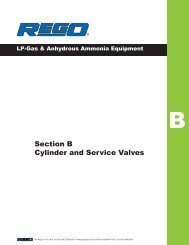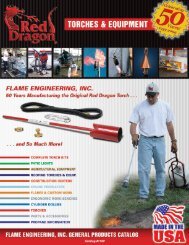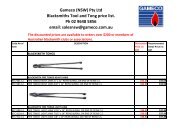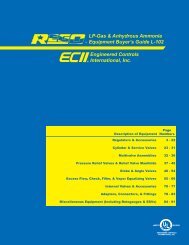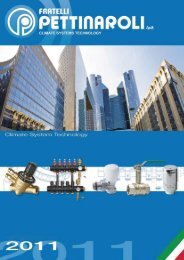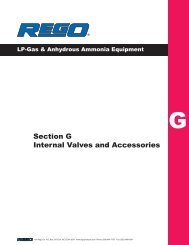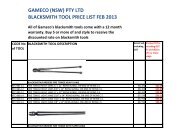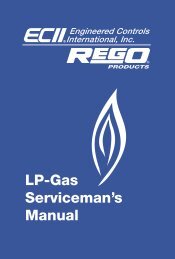Repair Kits Available By Part Number Section 2 Page - GAMECO
Repair Kits Available By Part Number Section 2 Page - GAMECO
Repair Kits Available By Part Number Section 2 Page - GAMECO
You also want an ePaper? Increase the reach of your titles
YUMPU automatically turns print PDFs into web optimized ePapers that Google loves.
Extra Tank Openings<br />
In many cases, the installation of a MultiPort TM results in one or more<br />
empty flanged openings in the container which were formerly<br />
occupied by individual flanged relief valves. These extra openings<br />
can either be sealed off or used for extra withdrawal capabilities.<br />
Openings can be sealed with properly sized and rated blind flanges.<br />
Extra threaded openings can be provided by using a screwed<br />
reducing flange with the required thread size.<br />
Figure 4<br />
4<br />
8<br />
1<br />
5<br />
Tighten bolt studs and nuts<br />
gradually in an alternate<br />
and opposite sequence<br />
around the diameter.<br />
Follow numberical<br />
sequence shown.<br />
3<br />
Relief Valve Removal<br />
NOTE: Before beginning relief valve removal or inspection, be sure<br />
protective eye wear and gloves are worn. Do not look directly into<br />
the relief valves at any time because they may discharge and cause<br />
bodily injury. No more than one relief valve may be removed from the<br />
manifold at any one time.<br />
The relief valve ports are numbered clockwise from the positioning<br />
handwheel. The one at the left of the handwheel is number one (1)<br />
and the one at the right is number four (4). Note the number of the<br />
manifold body port into which the relief valve to be removed is<br />
threaded. Turn the positioning handwheel until the number on the<br />
handwheel which corresponds to the number of the relief valve to<br />
be removed is in line with the arrow on the manifold body directly<br />
below the handwheel. See Figure 6. This procedure should position<br />
the manifold's shut-off disc under the desired port. Proper location<br />
and positioning of the shut-off disc can be checked using the<br />
bleeder valve directly below the port where the relief valve is to be<br />
removed – as instructed below.<br />
Turn the handwheel of the bleeder valve in a clockwise direction<br />
until it seats. See Figures 6 and 7. This procedure should allow<br />
propane vapor to bleed from the hole in the bleeder valve body and<br />
release the pressure between the manifold shut off-disc and the<br />
relief valve.<br />
After the discharge stops, the relief valve is ready to be removed. If<br />
the vapor continues to discharge for more than one minute, the<br />
manifold shut-off disc is either not fully seated or not properly<br />
positioned. The bleeder valve handwheel must then be back seated<br />
by turning in a counterclockwise direction to equalize the pressure.<br />
This should allow the free turning of the positioning handwheel for<br />
repositioning. When the manifold shut-off disc is properly positioned,<br />
the bleeding operation must then be repeated as earlier<br />
described.<br />
WARNING: Never attempt to move the manifold shut-off disc<br />
via the positioning hand wheel after pressure has been bled off<br />
or the relief valve has been removed.<br />
After the manifold shut-off disc has been properly positioned and<br />
the pressure beneath the relief valve has been bled out, the weep<br />
hole deflector must be removed from the relief valve. See Figure 8.<br />
Remove the weep hole deflector with an appropriate wrench. This<br />
provides clearance for gripping and turning the relief valve with a<br />
wrench.<br />
The relief valve may now be removed with an open end wrench,<br />
monkey wrench, pipe wrench or chain wrench applied to the hex<br />
section of the relief valve.<br />
If the relief valve cannot be replaced immediately, the rubber<br />
stopper must be placed in open port to prevent the entrance of<br />
foreign material. See Figure 9. Give the stopper a half turn to engage<br />
a few threads. Do not use a pipe plug or otherwise make a pressure<br />
tight seal. A seal would permit turning the positioning handwheel so<br />
another relief valve could be closed off. This would leave the<br />
container with inadequate protection and is not permissible.<br />
In some cases, it may be necessary to remove the positioning<br />
handwheel to facilitate removal of relief valves one and four. If this<br />
is done, carefully note the position of the handwheel and replace it<br />
in exactly the same position. This can be verified by matching the<br />
number of the closed port, the number on the handwheel and the<br />
arrow stamped on the manifold body pad directly below the<br />
handwheel.<br />
Figure 5<br />
Figure 6<br />
6<br />
2<br />
Bleeder Valves<br />
Turn counterclockwise<br />
until fully backseated<br />
during normal operation.<br />
7<br />
Relief Valve to Be Removed, # 4<br />
Weep Hole<br />
Deflectors (4)<br />
Handwheel –<br />
Turned to midway<br />
position for normal<br />
operations.<br />
Arrow on Body<br />
Do not attempt to move positioning handwheel<br />
after pressure has been bled off.<br />
Figure 7 – Bleeder Valve Detail<br />
Connects to<br />
area<br />
between<br />
manifold<br />
shut-off disc<br />
and relief<br />
valve<br />
Connects<br />
to Storage<br />
Container<br />
A3134-11B Weep Hole Deflector<br />
Step 1: Align corresponding number<br />
on handwheel of Relief Valve<br />
to be Replaced with arrow on<br />
manifold body.<br />
Step 2: Turn #4 bleeder valve<br />
clockwise slowly until closed.<br />
To Atmosphere<br />
Detail of Bleeder Valve<br />
in backseated position<br />
for normal operation.<br />
Permits equalization of<br />
pressures on both<br />
sides manifold shut-off<br />
disc when Relief Valve<br />
is installed.<br />
Detail of Bleeder Valve<br />
shown in closed position<br />
for relief valve removal.<br />
Permits pressure<br />
trapped between<br />
relief valve and manifold<br />
shut-off disc to<br />
bleed off so relief valve<br />
can be removed.



